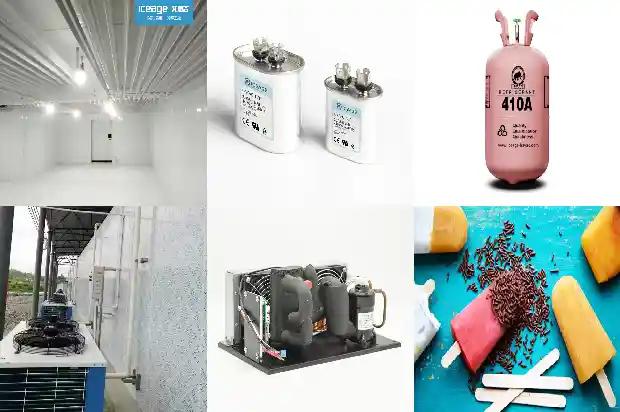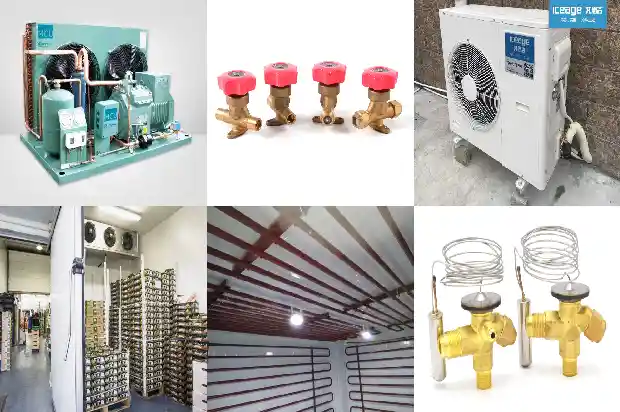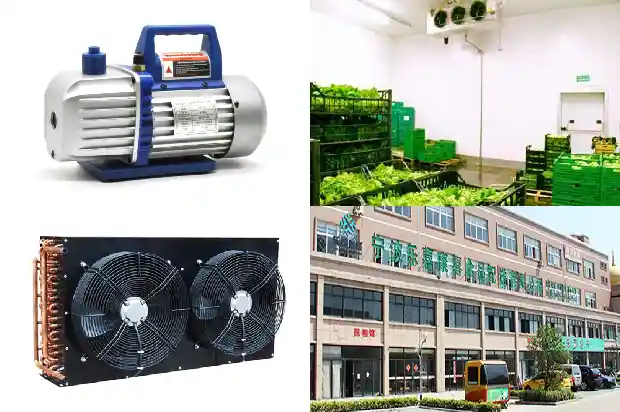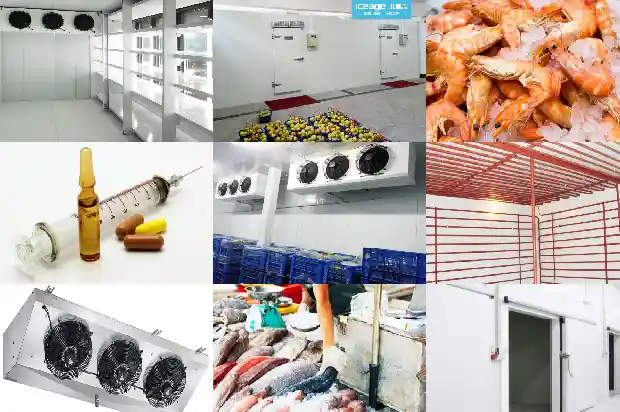Forms of Oil Separators
2024-09-30
In some exhaust pipelines (high-pressure side) of refrigeration systems, an oil separator (also abbreviated as oil separator) is installed. The principle of the oil separator is to utilize the different densities of oil and refrigerant. The mixed gas of refrigerant vapor and atomized lubricating oil discharged by the compressor passes through the special structure inside the oil separator, causing the lubricating oil to settle and separate from the mixture and then be sent back to the crankcase of the compressor. According to the different internal structures of the oil separator, there are various forms such as washing oil separator, centrifugal oil separator, packed oil separator, and mesh oil separator.
I. Washing oil separator
Most ammonia refrigeration systems use washing oil separators. The compressor exhaust gas directly enters the ammonia liquid from the top intake pipe. The ammonia liquid is stored in the lower part of the oil separator. The oil droplets in the ammonia gas are separated by washing with ammonia liquid. The separated gas enters the condenser through the pipe on the upper side of the oil separator. The liquid inlet of the washing oil separator is generally about 250mm lower than the liquid outlet of the condenser to maintain the liquid level of the oil separator.
II. Centrifugal oil separator
Ammonia refrigeration also uses centrifugal oil separators, also known as spiral oil separators. When the mixture of lubricating oil and refrigerant enters the oil separator, the mixture flows in a spiral along the blades and continuously impacts the guide plate. Under the action of centrifugal force, the heavier oil droplets in the mixture are separated and flow down along the inner wall of the shell. Then, after being controlled by a float valve, it enters the oil circuit system of the compressor or is discharged through an oil collector. The gas is 导出 through the gas outlet after filtration. The centrifugal oil separator needs to maintain a certain temperature to avoid the condensation of refrigerant vapor into liquid refrigerant in the oil separator when the unit is shut down. Once liquid refrigerant returns to the compressor through the oil return pipe, it will cause damage to the compressor.
III. Packed oil separator
Packed oil separators can be horizontal or vertical. There are various structural forms such as gas entering from the end and discharging from the side, or tangentially entering from the side and discharging from the end. The vertical packed oil separator is filled with stainless steel wire mesh or ceramic rings and other fillers in the inner sleeve of the cylinder. The separation of oil in this oil separator is achieved by reducing the gas flow rate and the contact filtration between oil droplets and fillers. When applied to screw chillers, the oil separation effect is better, and the oil separation effect can reach more than 99.9%. The disadvantage is that the resistance loss is relatively large.
IV. Mesh oil separator
Also called filter-type oil separator. The inside of this oil separator has a metal mesh and a polymer filter element. It is mostly used in Freon refrigeration systems. Through the filtering action of the metal wire mesh, the lubricating oil mixed in the gas refrigerant is separated and drips down and accumulates at the bottom of the container. Then, it returns to the compressor crankcase through the automatic oil return valve.
If the oil separation effect of the oil separator is not good, some oil and gas will enter the condenser and evaporator, forming an oil film on the surface of the heat exchanger, reducing the heat transfer effect and refrigeration efficiency. Usually, screw compressors are equipped with built-in oil separators. However, in some systems, they cannot meet the oil return requirements of the system, and an oil separator with higher external oil separation effect is needed. In the following situations, an oil separator is generally required: when using a flooded evaporator, when the gas discharged by the refrigerator contains more oil, when the exhaust pipe of the refrigerator is longer, and when the evaporation temperature is lower.
The selection of the oil separator mainly determines the diameter of the oil separator. Ensure that the flow rate of the refrigerant in the oil separator meets the oil separation requirements and achieves a good oil separation effect. When performing selection calculations, mainly involve the compressor volumetric efficiency coefficient (for two-stage compression, it refers to the high-pressure stage), the compressor's theoretical displacement (for two-stage compression, it refers to the high-pressure stage), and the flow rate of gas in the oil separator.
When installing the oil separator, it should be placed as close to the refrigerator as possible. When the refrigeration system stops working, it should prevent the condensation and accumulation of liquid refrigerant in the oil separator. When the compressor resumes operation, it should also prevent refrigerant liquid from entering the compressor.
The oil drainage of the oil separator is carried out when the compressor stops running. For ammonia systems, in order to ensure safety, oil drainage must be carried out through an oil collector. In addition, at least one sewage discharge should be carried out every year.

I. Washing oil separator
Most ammonia refrigeration systems use washing oil separators. The compressor exhaust gas directly enters the ammonia liquid from the top intake pipe. The ammonia liquid is stored in the lower part of the oil separator. The oil droplets in the ammonia gas are separated by washing with ammonia liquid. The separated gas enters the condenser through the pipe on the upper side of the oil separator. The liquid inlet of the washing oil separator is generally about 250mm lower than the liquid outlet of the condenser to maintain the liquid level of the oil separator.
II. Centrifugal oil separator
Ammonia refrigeration also uses centrifugal oil separators, also known as spiral oil separators. When the mixture of lubricating oil and refrigerant enters the oil separator, the mixture flows in a spiral along the blades and continuously impacts the guide plate. Under the action of centrifugal force, the heavier oil droplets in the mixture are separated and flow down along the inner wall of the shell. Then, after being controlled by a float valve, it enters the oil circuit system of the compressor or is discharged through an oil collector. The gas is 导出 through the gas outlet after filtration. The centrifugal oil separator needs to maintain a certain temperature to avoid the condensation of refrigerant vapor into liquid refrigerant in the oil separator when the unit is shut down. Once liquid refrigerant returns to the compressor through the oil return pipe, it will cause damage to the compressor.
III. Packed oil separator
Packed oil separators can be horizontal or vertical. There are various structural forms such as gas entering from the end and discharging from the side, or tangentially entering from the side and discharging from the end. The vertical packed oil separator is filled with stainless steel wire mesh or ceramic rings and other fillers in the inner sleeve of the cylinder. The separation of oil in this oil separator is achieved by reducing the gas flow rate and the contact filtration between oil droplets and fillers. When applied to screw chillers, the oil separation effect is better, and the oil separation effect can reach more than 99.9%. The disadvantage is that the resistance loss is relatively large.
IV. Mesh oil separator
Also called filter-type oil separator. The inside of this oil separator has a metal mesh and a polymer filter element. It is mostly used in Freon refrigeration systems. Through the filtering action of the metal wire mesh, the lubricating oil mixed in the gas refrigerant is separated and drips down and accumulates at the bottom of the container. Then, it returns to the compressor crankcase through the automatic oil return valve.
If the oil separation effect of the oil separator is not good, some oil and gas will enter the condenser and evaporator, forming an oil film on the surface of the heat exchanger, reducing the heat transfer effect and refrigeration efficiency. Usually, screw compressors are equipped with built-in oil separators. However, in some systems, they cannot meet the oil return requirements of the system, and an oil separator with higher external oil separation effect is needed. In the following situations, an oil separator is generally required: when using a flooded evaporator, when the gas discharged by the refrigerator contains more oil, when the exhaust pipe of the refrigerator is longer, and when the evaporation temperature is lower.
The selection of the oil separator mainly determines the diameter of the oil separator. Ensure that the flow rate of the refrigerant in the oil separator meets the oil separation requirements and achieves a good oil separation effect. When performing selection calculations, mainly involve the compressor volumetric efficiency coefficient (for two-stage compression, it refers to the high-pressure stage), the compressor's theoretical displacement (for two-stage compression, it refers to the high-pressure stage), and the flow rate of gas in the oil separator.


When installing the oil separator, it should be placed as close to the refrigerator as possible. When the refrigeration system stops working, it should prevent the condensation and accumulation of liquid refrigerant in the oil separator. When the compressor resumes operation, it should also prevent refrigerant liquid from entering the compressor.
The oil drainage of the oil separator is carried out when the compressor stops running. For ammonia systems, in order to ensure safety, oil drainage must be carried out through an oil collector. In addition, at least one sewage discharge should be carried out every year.

Related Articles
- Has Your Refrigeration System Experienced "Oil Carry - over"?
- Causes and Prevention of "Primary Condensation" and "Secondary Condensation" in Fan - Coil Units
- Common Faults of HVAC Fan Coil Units
- Introduction to Oil Collector in Refrigeration System
- How to troubleshoot dirty blockage, ice blockage and oil blockage in refrigeration systems?
- Installation and Oil Return Precautions for Refrigeration Equipment Pipelines
- Precautions for Replacing Refrigeration Compressor Refrigerant Oil
- What are the reasons for the poor oil return of screw compressors?
- Freezing Chamber System Blockage, Dirty Blockage, and Oil Blockage Characteristics and Treatment Methods
- Oil Cooling Methods and Oil Leakage Operations for Screw Compressors
